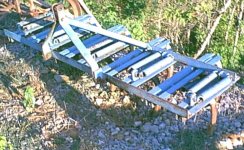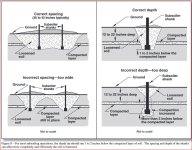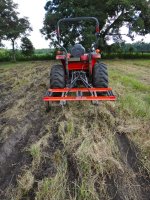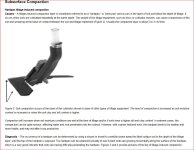I picked up a f6 foot field cultivator the other day for my food plots. What a great tool. I've used a 3pt tiller originally so the ground is broken up but the field cultivator digs a bit deeper and is faster. It also gathers up great bunches of tall weeds on patches I've let go for a couple of years...like a rake. I can see this is going to be my favorite tool. When it hits a rock the tines pop up and reset. Good for me as I find rocks easily.
It needs a few springs, which I've found on a craiglist ad from Fayetteville, Arkansas. If you need some springs, this guy bought a bunch of them and they are NOS and appear to be the correct length and size.
I thought this was a Ford or Dearborn, maybe a Ferguson, from the 40s or later. Similar to the current versions by Dirt Dog, Everything Attachments, and others. But I don't think it is any of those. The only picture I've located is one posted by Ken Sweet a few years ago on this very website that he had for sale at the time. I copied and posted his picture. His is a lot bluer than mine. The key difference to the Fords, etc. on is the way the 3pt bracket is attached to the angle iron frames. I contacted Ken but he didn't know the make or model. He's pretty knowledgeable. Had that picture not been available I'd have thought it was perhaps homemade or altered.
It looks like a similar design to many others but its just not quite a fit. I don't think its been cut down or altered as the bolts I've taken off look like they are 60 plus years' old. I've looked at old ads, parts books, and a zillon pictures but the only one just like it was Kens. Its not critical that I know what it is, as there wouldn't be any original parts available anyway.
It needs a few springs, which I've found on a craiglist ad from Fayetteville, Arkansas. If you need some springs, this guy bought a bunch of them and they are NOS and appear to be the correct length and size.
I thought this was a Ford or Dearborn, maybe a Ferguson, from the 40s or later. Similar to the current versions by Dirt Dog, Everything Attachments, and others. But I don't think it is any of those. The only picture I've located is one posted by Ken Sweet a few years ago on this very website that he had for sale at the time. I copied and posted his picture. His is a lot bluer than mine. The key difference to the Fords, etc. on is the way the 3pt bracket is attached to the angle iron frames. I contacted Ken but he didn't know the make or model. He's pretty knowledgeable. Had that picture not been available I'd have thought it was perhaps homemade or altered.
It looks like a similar design to many others but its just not quite a fit. I don't think its been cut down or altered as the bolts I've taken off look like they are 60 plus years' old. I've looked at old ads, parts books, and a zillon pictures but the only one just like it was Kens. Its not critical that I know what it is, as there wouldn't be any original parts available anyway.




